Book contents
- Practical Emergency Resuscitation and Critical Care
- Practical Emergency Resuscitation and Critical Care
- Copyright page
- Contents
- Contributors
- Preface
- Section 1 General Critical Care
- Section 2 Infectious Disease Emergencies
- 5 Covid-19
- 6 Sepsis and Septic Shock
- 7 Pneumonia
- 8 Meningitis and Encephalitis
- 9 Infective Endocarditis
- 10 Necrotizing Soft Tissue Infections
- 11 Complications of Human Immunodeficiency Virus (HIV) and Acquired Immunodeficiency Syndrome (AIDS)
- Section 3 Neurological Emergencies
- Section 4 Cardiovascular Emergencies
- Section 5 Respiratory Emergencies
- Section 6 Gastrointestinal Emergencies
- Section 7 Renal Emergencies
- Section 8 Hematology–Oncology Emergencies
- Section 9 Endocrine Emergencies
- Section 10 Environmental Emergencies
- Section 11 Trauma
- Section 12 End of Life
- Index
- References
5 - Covid-19
from Section 2 - Infectious Disease Emergencies
Published online by Cambridge University Press: 02 November 2023
- Practical Emergency Resuscitation and Critical Care
- Practical Emergency Resuscitation and Critical Care
- Copyright page
- Contents
- Contributors
- Preface
- Section 1 General Critical Care
- Section 2 Infectious Disease Emergencies
- 5 Covid-19
- 6 Sepsis and Septic Shock
- 7 Pneumonia
- 8 Meningitis and Encephalitis
- 9 Infective Endocarditis
- 10 Necrotizing Soft Tissue Infections
- 11 Complications of Human Immunodeficiency Virus (HIV) and Acquired Immunodeficiency Syndrome (AIDS)
- Section 3 Neurological Emergencies
- Section 4 Cardiovascular Emergencies
- Section 5 Respiratory Emergencies
- Section 6 Gastrointestinal Emergencies
- Section 7 Renal Emergencies
- Section 8 Hematology–Oncology Emergencies
- Section 9 Endocrine Emergencies
- Section 10 Environmental Emergencies
- Section 11 Trauma
- Section 12 End of Life
- Index
- References
Summary
Severe acute respiratory syndrome coronavirus 2 (SARS-CoV-2) caused the pandemic declared in March 2020. While many of the manifestations (i.e., acute respiratory distress syndrome [ARDS]) are similar to other severe respiratory viruses, there is an increasing number of specific therapeutics found to be effective in combating coronavirus disease 2019 (COVID-19). As data emerge on the optimal treatment of COVID-19, the recommendations in this chapter are based on the current consensus from large global health and infectious disease authorities but are subject to evolution of the evidence.
- Type
- Chapter
- Information
- Practical Emergency Resuscitation and Critical Care , pp. 49 - 57Publisher: Cambridge University PressPrint publication year: 2023



